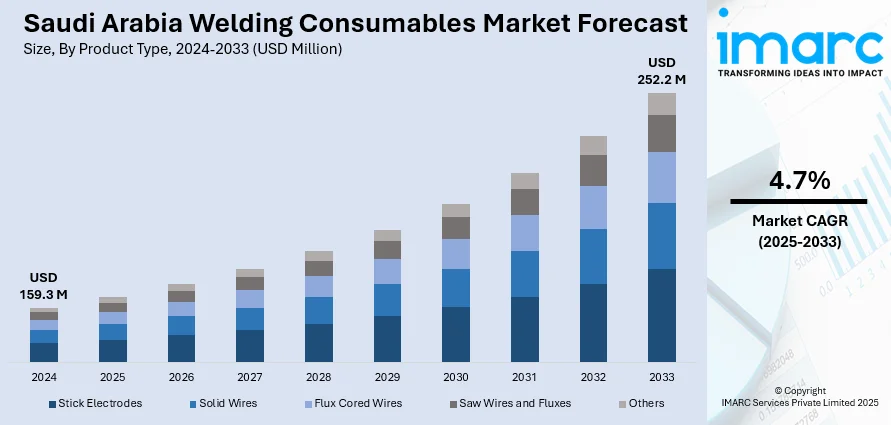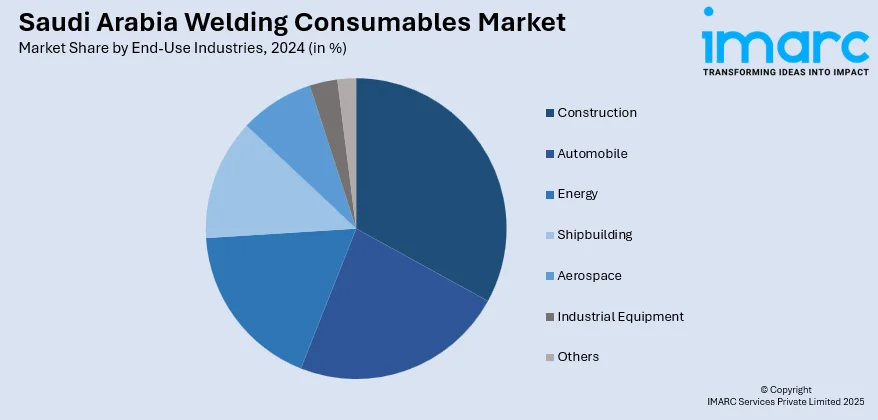
Saudi Arabia Welding Consumables Market Size, Share, Trends and Forecast by Product Type, Welding Technique, End-Use Industries, and Region, 2025-2033
Saudi Arabia Welding Consumables Market Overview:
The Saudi Arabia welding consumables market size reached USD 159.3 Million in 2024. Looking forward, IMARC Group expects the market to reach USD 252.2 Million by 2033, exhibiting a growth rate (CAGR) of 4.7% during 2025-2033. Rising infrastructure development, growing oil and gas projects, expansion in the petrochemical and manufacturing sectors, and increasing government investments are some of the factors propelling the growth of the market. Demand for automation in welding processes and industrial maintenance further supports market growth across key industries.
|
Report Attribute
|
Key Statistics
|
|---|---|
|
Base Year
|
2024
|
|
Forecast Years
|
2025-2033
|
|
Historical Years
|
2019-2024
|
| Market Size in 2024 | USD 159.3 Million |
| Market Forecast in 2033 | USD 252.2 Million |
| Market Growth Rate 2025-2033 | 4.7% |
Saudi Arabia Welding Consumables Market Trends:
Steady Market Expansion Driven by Industrial Growth
Saudi Arabia’s welding consumables market is aligning with the broader global movement toward steady expansion, supported by long-term industrial and infrastructure initiatives. Rising investments in sectors such as construction, energy, and manufacturing continue to boost demand for welding materials, especially in large-scale fabrication and maintenance activities. As major industrial hubs expand, the requirement for high-performance electrodes, wires, and fluxes is increasing to support reliable, high-strength welds in critical applications. The forecasted international growth trajectory signals strong future potential for local suppliers and distributors, particularly those offering technologically advanced and application-specific products. Additionally, the region’s growing adoption of automated and semi-automated welding processes is pushing for greater quality and consistency in consumables. With a focus on modernizing fabrication capabilities and enhancing productivity, the domestic market is expected to benefit from global market forces and national development strategies alike, positioning it for consistent upward momentum through the next decade. For example, the global welding consumables market size reached USD 17.7 Billion in 2024. Looking forward, IMARC Group expects the market to reach USD 26.3 Billion by 2033, exhibiting a growth rate (CAGR) of 4.49% during 2025-2033.

Automation-Driven Welding Innovation Gaining Ground
Saudi Arabia’s welding consumables market is witnessing a growing preference for high-performance systems that reduce dependency on manual skill. New welding platforms designed for heavy industrial use are enabling operators, regardless of experience level, to deliver consistent results with simplified setup procedures. This reflects a broader movement toward smart, user-friendly equipment that enhances efficiency and productivity across sectors such as construction, shipbuilding, and oil and gas. The shift also supports the country’s industrial diversification goals under Vision 2030, where advanced manufacturing capabilities are becoming increasingly critical. As industrial projects expand, demand is rising for consumables compatible with automated and semi-automated welding solutions. The local market is expected to experience a shift from conventional processes toward digitally optimized systems that combine ease of use with robust output performance, aligning with the workforce’s evolving needs and the sector’s push for modernization. For instance, in November 2023, ESAB introduced a next-generation welding platform for heavy industrial welding. Both new and experienced welders may produce outstanding welding results with ESAB's Warrior Edge 500 CX system, which does not require a difficult setup process.
Saudi Arabia Welding Consumables Market Segmentation:
IMARC Group provides an analysis of the key trends in each segment of the market, along with forecasts at the region/country level for 2025-2033. Our report has categorized the market based on product type, welding technique, and end-use industries.
Product Type Insights:
- Stick Electrodes
- Solid Wires
- Flux Cored Wires
- Saw Wires and Fluxes
- Others
The report has provided a detailed breakup and analysis of the market based on the product type. This includes stick electrodes, solid wires, flux cored wires, SAW wires and fluxes, and others.
Welding Technique Insights:
- Arc Welding
- Resistance Welding
- Oxy-Fuel Welding
- Ultrasonic Welding
- Others
The report has provided a detailed breakup and analysis of the market based on the welding technique. This includes arc welding, resistance welding, oxy-fuel welding, ultrasonic welding, and others.
End-Use Industries Insights:

- Construction
- Automobile
- Energy
- Shipbuilding
- Aerospace
- Industrial Equipment
- Others
A detailed breakup and analysis of the market based on the end-use industries have also been provided in the report. This includes construction, automobile, energy, shipbuilding, aerospace, industrial equipment, and others.
Regional Insights:
- Northern and Central Region
- Western Region
- Eastern Region
- Southern Region
The report has also provided a comprehensive analysis of all the major regional markets, which include Northern and Central Region, Western Region, Eastern Region, and Southern Region.
Competitive Landscape:
The market research report has also provided a comprehensive analysis of the competitive landscape. Competitive analysis such as market structure, key player positioning, top winning strategies, competitive dashboard, and company evaluation quadrant has been covered in the report. Also, detailed profiles of all major companies have been provided.
Saudi Arabia Welding Consumables Market News:
- In May 2024, voestalpine Böhler Welding acquired a majority stake in ITALFIL S.p.A., enhancing its portfolio in semi and fully-automated high-quality welding technologies. This move strengthens its position in the Saudi Arabia welding consumables market, where demand is rising for advanced welding solutions across infrastructure, oil and gas, and manufacturing sectors aligned with Vision 2030 industrial goals.
- In January 2024, Lincoln Electric's newest pipe solution, Mechanized Pipeliner AutoShield, was introduced, which is an innovative method for pipeline welding. AutoShield is designed to weld fill and cap passes without using shielding gas on a mechanized orbital system, maximizing economy and performance. This technology allows contractors to mechanize more easily and affordably, resulting in uniform welds and providing operators with a new tool to accomplish something different.
Saudi Arabia Welding Consumables Market Report Coverage:
| Report Features | Details |
|---|---|
| Base Year of the Analysis | 2024 |
| Historical Period | 2019-2024 |
| Forecast Period | 2025-2033 |
| Units | Million USD |
| Scope of the Report |
Exploration of Historical Trends and Market Outlook, Industry Catalysts and Challenges, Segment-Wise Historical and Future Market Assessment:
|
| Product Types Covered | Stick Electrodes, Solid Wires, Flux Cored Wires, Saw Wires and Fluxes, Others |
| Welding Techniques Covered | Arc Welding, Oxy-Fuel Welding, Resistance Welding, Ultrasonic Welding, Others |
| End-Use Industries Covered | Construction, Automobile, Energy, Shipbuilding, Aerospace, Industrial Equipment, Others |
| Regions Covered | Northern and Central Region, Western Region, Eastern Region, Southern Region |
| Customization Scope | 10% Free Customization |
| Post-Sale Analyst Support | 10-12 Weeks |
| Delivery Format | PDF and Excel through Email (We can also provide the editable version of the report in PPT/Word format on special request) |
Key Questions Answered in This Report:
- How has the Saudi Arabia welding consumables market performed so far and how will it perform in the coming years?
- What is the breakup of the Saudi Arabia welding consumables market on the basis of product type?
- What is the breakup of the Saudi Arabia welding consumables market on the basis of welding technique?
- What is the breakup of the Saudi Arabia welding consumables market on the basis of end-use industries?
- What is the breakup of the Saudi Arabia welding consumables market on the basis of region?
- What are the various stages in the value chain of the Saudi Arabia welding consumables market?
- What are the key driving factors and challenges in the Saudi Arabia welding consumables?
- What is the structure of the Saudi Arabia welding consumables market and who are the key players?
- What is the degree of competition in the Saudi Arabia welding consumables market?
Key Benefits for Stakeholders:
- IMARC’s industry report offers a comprehensive quantitative analysis of various market segments, historical and current market trends, market forecasts, and dynamics of the Saudi Arabia welding consumables market from 2019-2033.
- The research report provides the latest information on the market drivers, challenges, and opportunities in the Saudi Arabia welding consumables market.
- Porter's five forces analysis assist stakeholders in assessing the impact of new entrants, competitive rivalry, supplier power, buyer power, and the threat of substitution. It helps stakeholders to analyze the level of competition within the Saudi Arabia welding consumables industry and its attractiveness.
- Competitive landscape allows stakeholders to understand their competitive environment and provides an insight into the current positions of key players in the market.
Need more help?
- Speak to our experienced analysts for insights on the current market scenarios.
- Include additional segments and countries to customize the report as per your requirement.
- Gain an unparalleled competitive advantage in your domain by understanding how to utilize the report and positively impacting your operations and revenue.
- For further assistance, please connect with our analysts.
 Request Customization
Request Customization
 Speak to an Analyst
Speak to an Analyst
 Request Brochure
Request Brochure
 Inquire Before Buying
Inquire Before Buying




.webp)




.webp)












